The Art of Blending: Can Your Bowling Ball Adapt?
Bowling is not just a game of skill; it is also an art that requires understanding the dynamics of your equipment. One of the critical aspects of achieving high bowling performance is the ability to adapt your bowling ball to various lane conditions. This article delves into the blending techniques that can enhance your game, focusing on how you can make your bowling ball work for you through advanced ball dynamics and adaptive technology.
Understanding the Basics of Bowling Ball Dynamics
Before diving into blending techniques, it’s essential to grasp the fundamentals of bowling ball dynamics. The behavior of a bowling ball on the lane is influenced by several factors:
- Surface Texture: The texture of the bowling ball affects its grip on the lane.
- Weight Block Design: The core design influences the ball’s roll and hook potential.
- Coverstock Material: The material composition impacts how the ball interacts with the lane surface.
Understanding these dynamics allows bowlers to make informed decisions about their equipment, leading to improved bowling performance.
Blending Techniques to Enhance Your Game
Blending techniques involve adjusting your bowling ball to match the lane conditions effectively. Here’s a step-by-step guide to help you master these techniques:
Step 1: Assess Lane Conditions
Before you start playing, analyze the lane conditions. Factors such as oil patterns, lane surface, and the overall environment play a significant role in how your ball will perform. Here are some common lane conditions:
- Heavy Oil: Requires a ball with a stronger coverstock to create more traction.
- Medium Oil: A versatile ball can be effective here, often a hybrid that blends characteristics.
- Light Oil: A reactive ball can help achieve a higher hook potential.
Step 2: Choose the Right Bowling Ball
Based on your assessment, select a bowling ball that suits the lane conditions. Consider the following:
- Coverstock Type: Reactive resin balls work best on medium to dry lanes.
- Core Design: Symmetrical cores provide a smoother transition, while asymmetrical cores offer more hook potential.
Step 3: Customize Your Ball
Sometimes, a stock bowling ball may need adjustments to maximize its potential. Here’s how to customize:
- Surface Adjustments: Alter the surface by sanding or polishing to change friction levels.
- Weight Hole Drilling: Adding or adjusting weight holes can influence the ball’s dynamics.
Utilizing these blending techniques will allow your bowling ball to adapt to various conditions, enhancing your overall game.
Equipment Testing: The Key to Finding Your Perfect Fit
Testing your bowling ball is crucial for understanding how it reacts on different lane conditions. Here’s how to effectively test your equipment:
1. Setup a Testing Environment
Use a consistent environment, ideally a bowling alley with varying lane patterns. Document the oil patterns for future reference.
2. Perform Test Shots
Take multiple shots with different balls and adjustments. Observe:
- Hook potential
- Pin carry
- Consistency of strikes
3. Analyze Performance
After testing, analyze your results. Note which ball and adjustments led to the best bowling performance. This data will help you make informed decisions in future games.
Troubleshooting Common Issues
Even with the best equipment, bowlers may face challenges. Here are some common issues and their solutions:
Issue 1: Inconsistent Hook
Solution: Check your grip and release technique. Ensure that you are consistent with your hand position and follow-through. Adjust the surface of your ball if necessary.
Issue 2: Poor Pin Carry
Solution: Experiment with different bowling balls and their dynamics. Sometimes, a change in the weight block or coverstock can make a significant difference.
Issue 3: Ball Not Reacting as Expected
Solution: Reassess lane conditions. If they have changed during your game, you may need to adjust your strategy or equipment accordingly.
Bowling Strategy: Utilizing Adaptive Technology
With the advent of sports innovation, many bowlers are now utilizing adaptive technology to enhance their game. Here are some strategies to consider:
- Smart Bowling Balls: Some manufacturers have developed bowling balls equipped with sensors that provide real-time feedback on performance.
- Mobile Apps: Use apps to track your scores, analyze your performance, and receive tailored advice based on your data.
- Video Analysis: Record your bowling technique to identify areas for improvement.
By embracing these technologies, bowlers can fine-tune their equipment and strategies, leading to improved bowling performance.
Conclusion: Mastering the Art of Blending
In conclusion, the art of blending your bowling ball to adapt to various lane conditions is essential for achieving optimal bowling performance. By understanding ball dynamics, employing blending techniques, and utilizing adaptive technology, you can significantly enhance your game. Remember, the key is to continuously test and adjust your equipment while analyzing your performance. This approach will not only help you become a more versatile bowler but also keep you ahead in the ever-evolving world of bowling.
For further reading on bowling techniques and equipment, check out this comprehensive guide. To stay updated on the latest innovations in bowling technology, visit Bowling Innovations.
This article is in the category Equipment and created by BowlingPulse Team
